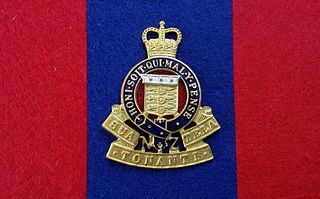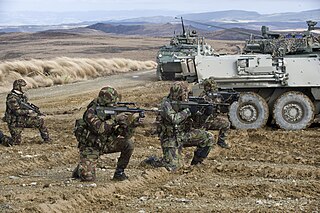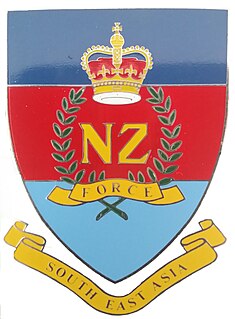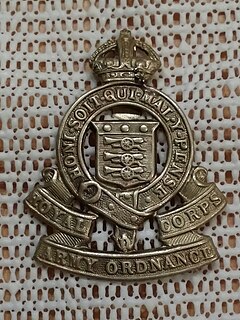
A non-commissioned officer (NCO) is a military officer who has not earned a commission. Non-commissioned officers usually obtain their position of authority by promotion through the enlisted ranks. In contrast, commissioned officers usually enter directly from a military academy, Officer Candidate School (OCS), or Officer Training School (OTS) after receiving a post-secondary degree.

Sergeant ( SARJ-ənt; abbreviated to Sgt. and capitalized when used as a named person's title, is a rank in many uniformed organizations, principally military and policing forces. The alternative spelling, serjeant, is used in The Rifles and other units that draw their heritage from the British light infantry. Its origin is the Latin serviens, 'one who serves,' through the French term sergeant.
Staff sergeant is a rank of non-commissioned officer used in the armed forces of many countries. It is also a police rank in some police services.

Burnham, also known as Burnham Camp, is the largest army base in New Zealand's South Island. It is located 28 kilometres south of Christchurch on the Canterbury Plains in the Selwyn District, close to the town of Dunsandel. Burnham was named after Burnham Beeches, Buckinghamshire.

The Royal New Zealand Infantry Regiment is the parent administrative regiment and corps of regular and reserve infantry battalions in the New Zealand Army. It was originally formed in 1947 with a singular Regular regiment and multiple reserve regiments. Over time, the regiments were turned into battalions, the reserve units amalgamated and more regular units raised and disbanded. Currently, the Regiment currently consists of two regular and three reserve battalions. Throughout its existence, units raised in this regiment have served and deployed on operations in Malaya, Vietnam, Borneo and various United Nations peacekeeping operations.

6th Battalion, Royal Australian Regiment is a mechanised infantry battalion of the Australian Army. It was originally raised in Brisbane, Queensland, on 6 June 1965 and has since then served in a number of overseas deployments and conflicts including South Vietnam, East Timor, Iraq and Afghanistan. During the Vietnam War, the battalion earned a US Presidential Unit Citation from the United States when members from 'D' Company participated in the Battle of Long Tan on 18–19 August 1966. The battalion is currently based at Gallipoli Barracks in Brisbane and forms part of the 7th Brigade.

Her Majesty's Naval Base, Singapore, alternatively known as Singapore Naval Base, Sembawang Naval Base and HMS Sembawang, was situated in Sembawang at the northern tip of Singapore and was both a Royal Navy shore establishment and a cornerstone of British defence policy in the Far East between the World Wars. From 1921 to 1941 it was a base of the China Station and from 1941 to 1958 it was a base for the Far East Fleet. Today, it is a commercial dockyard but British military activity still exists at the British Defence Singapore Support Unit (BDSSU).

ANZUK was a tripartite force formed by Australia, New Zealand and the United Kingdom to defend the Asian Pacific region after the United Kingdom withdrew forces from the east of Suez in the early 1970s. The ANZUK force was formed in Singapore on 1 November 1971 under Rear Admiral David Wells and disbanded in 1974.

New Zealand's involvement in the Vietnam War was highly controversial, sparking widespread protest at home from anti-Vietnam War movements modelled on their American counterparts. This conflict was also the first in which New Zealand did not fight alongside the United Kingdom, instead following the loyalties of the ANZUS Pact.

The ANZUK Ordnance Depot was established in 1971 to provide logistical support to Australian, New Zealand and British forces stationed in Singapore and Malaysia as part of ANZUK Force. It was commanded by a Royal Army Ordnance Corps officer of the rank of lieutenant colonel and staffed by Australian, New Zealand and United Kingdom personnel and Locally Employed Civilians. This organisation operated for only a short period. Australia changed Government in 1972 and the incoming Labor Government decided to withdraw Australia’s commitment to the region. This took effect in 1974 and was followed later by the withdrawal of the British forces. It was then decided that New Zealand should form its own Advanced Ordnance Depot, designated the New Zealand Advanced Ordnance Depot (NZAOD). This was the start of a commitment which was to last until December 1989.
The Battle of Núi Lé was the last major battle fought by Australian and New Zealand forces in South Vietnam. The battle was fought in the former Phước Tuy Province between elements of the People's Army of Vietnam (PAVN) 33rd Regiment and 'B' and 'D' Companies of the 4RAR/NZ (ANZAC) Battalion and during Operation Ivanhoe. Núi Lé, a small hill within Quang Thanh commune in Chau Duc District, is today in Ba Ria-Vung Tau Province.

The New Zealand Intelligence Corps (NZIC) analyses information from a variety of sources and provides commanders with intelligence on such things as enemy locations, capabilities and intentions. Corps personnel also provide advice on Field Security on operations.

This article describes the current structure of the New Zealand Army. It includes the army's order of battle and the headquarters locations of major units.

No. 41 Squadron was a transport unit of the Royal New Zealand Air Force (RNZAF). The squadron was formed in 1944, and conducted transport flights in the south Pacific during World War II. It remained active after the war, and flew supplies to the New Zealand occupation force in Japan. Three crews from the squadron participated in the Berlin Airlift during 1948 and 1949, and one of its flights was temporarily based in Singapore from 1949 to 1951. From 1955 the entire squadron was stationed at Singapore, from where it participated in the Malayan Emergency, Indonesia–Malaysia confrontation and Vietnam War. Detachments of No. 41 Squadron were also based in Thailand from 1962 to 1965. The squadron was disbanded in 1977.

The Royal New Zealand Army Ordnance Corps (RNZAOC) concerned itself with the provisioning of troops with the means to fight; specifically uniforms, weapons and equipment. Ordnance functions go back hundreds of years; the first Ordnance Officer in the British military appeared in the year 1299. Designated "Keeper of the King's Wardrobe", his duties included the care and accounting of heavy equipment such as battering rams and catapults.

New Zealand Force South East Asia (NZFORSEA) (1974–1989) comprised the elements of the Royal New Zealand Navy, New Zealand Army and Royal New Zealand Air Force. Much of the New Zealand military left Singapore as part of operation Kupe in 1989, leaving behind a residual Defence Support Unit (NZDSU).
The New Zealand Army contributed Royal New Zealand Army Ordnance Corps (RNZAOC) supply elements to the International and United Nations Operation in Somalia (UNOSOM) efforts in Somalia.
From four Stores Depots in the main centres of New Zealand at the beginning of the 20th century, the Royal New Zealand Army Ordnance Corps (RNZAOC) expanded and shrank to meet the operational needs of the NZ Army, Ordnance units have been deployed worldwide and across the breath and width of New Zealand.

With the adoption of the Singapore strategy in the 1920s as a key cornerstone of Imperial Defence, Singapore and Malaya became the major British bases in the East, not only to defend British possessions in Asia, but also the Dominions of Australia and New Zealand, who also contributed a large portion of the construction costs.













